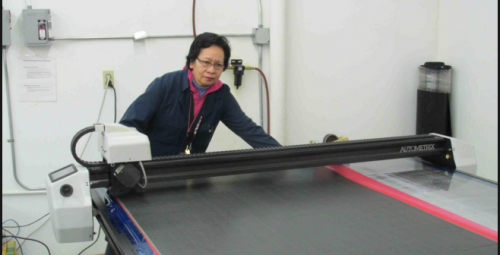
Case Study: Replacing an Aluminum Tool Mount with a 3D Printed Bracket
Autometrix manufactures automated textile cutting systems, pattern design and pattern digitization software. The cutting systems are CNC based, boasting the smoothest, fastest motion control available. Autometrix machines are used all over the world to make clothing, sails, equipment insulation and much more.
Autometrix uses the Mark One Composite 3D Printer for prototyping and plans to replace a number of aluminum parts with Kevlar® reinforced composite parts. The first two composite parts tested were a cutting head bracket and a cutting-tool mount. The gains in lead time, reduction of cost, and elimination of inventory make the Mark One a no-brainer for their business.
Introducing Autometrix
Autometrix is a market leader in the automated fabric cutting systems. They make large scale machines for cutting nearly any textile. The machines are used to cut countless patterns each and every day.
Autometrix also makes pattern optimization software and production management software to optimize use of their machines. They supply everything customers like Eagle Sports or NOMAR need to manufacture high quality products.

In their own words, “Autometrix’s 7th generation cutting systems are fast and precise, perfect for single-ply or low-ply cutting operations. They are simple, rugged, and easy to operate. Our design philosophy results in the smoothest motion and the best reliability in the industry”
A Culture of Continuous Innovation
All engineering and production is done in-house at Autometrix’ Grass Valley, CA, headquarters. This gives them complete control over quality and retains useful institutional knowledge. It also creates a culture where everyone is able to contribute and innovate.
A part of the culture of Autometrix is innovation and a focus on quality. Several members of the Autometrix design team have experience with 3D printing using maker level desktop 3D printers. When MarkForged came onto their radar, the idea that 3D printed parts might find a place at Autometrix was readily accepted.

Using sample parts from a Robo3D printer, the idea took shape. While the parts from the Robo3D weren’t strong enough for the Autometrix machinery, they convinced the team that there was an opportunity to replace some traditional aluminum parts if they could find a printer capable of making stronger parts.
Replacing the First Two Parts
Autometrix found the Mark One and quickly went through the sales process. The geometry of the parts and required strength was well within the capability of the Mark One. The printer arrived and was easy to get started. According to the engineering staff, “It’s well documented, and we didn’t have any trouble setting it up and starting the materials.”
Autometrix workflow was to model the parts in Inventor and then send the CAD files to the machine shop. Switching was just a matter of exporting the Inventor files as STLs, then importing them into the Markforged Eiger software.
The first two parts they replaced were the cutting head bracket and cutting head tool mount. These parts are located on the machine’s cutting head and hold the cutting tools. Both parts were replaced by Kevlar®-reinforced-nylon parts.


Kevlar is a great choice for this because it handles torsional loads and impacts very well. The nylon matrix helps to evenly spread the load across the entirety of the part.
Adding fiber and scaling the parts was easy through the web interface. The Markforged software sliced the Inventor files and automatically added fiber reinforcement.

Printing the parts was also friction-free. The MarkForged software allowed their engineers to send files to the printer hassle free. They describe it as, “It’s just a matter of hitting print and walking away.”
The 3D Printed Part is a Good Solution
Composite 3d printing is especially apt for Autometrix because they already design the parts to handle torsion. This is both to support cutting dozens and dozens of patterns of day and to ensure the printer survives the rigors of a manufacturing facility where parts of the machine might get hit periodically with large rolls of material, or where a mistake with a forklift might lead to heavy items impacting the machine.
The materials property of the nylon makes it well-suited to these periodic impacts. The cutting head tool mount bounces back without cracking or bending, and a machine user’s workflow can remain unaffected.
Overall, the flexibility the Mark One provides to Autometrix generates benefits starting at Engineering to Production, all the way down to the end user of their cutting machines.

Autometrix Tool Holder Specifications
Size: 119.06mm x 62.86mm x 23.79mm; Print Time: ~7h 22m; Nylon Cost: $6.57; Kevlar® Cost: $2.03
All of the blogs and the information contained within those blogs are copyright by Markforged, Inc. and may not be copied, modified, or adopted in any way without our written permission. Our blogs may contain our service marks or trademarks, as well as of those our affiliates. Your use of our blogs does not constitute any right or license for you to use our service marks or trademarks without our prior permission. Markforged Information provided in our blogs should not be considered professional advice. We are under no obligation to update or revise blogs based on new information, subsequent events, or otherwise.
不错过任何一篇文章
订阅以在您的收件箱中获取新的 Markforged 内容